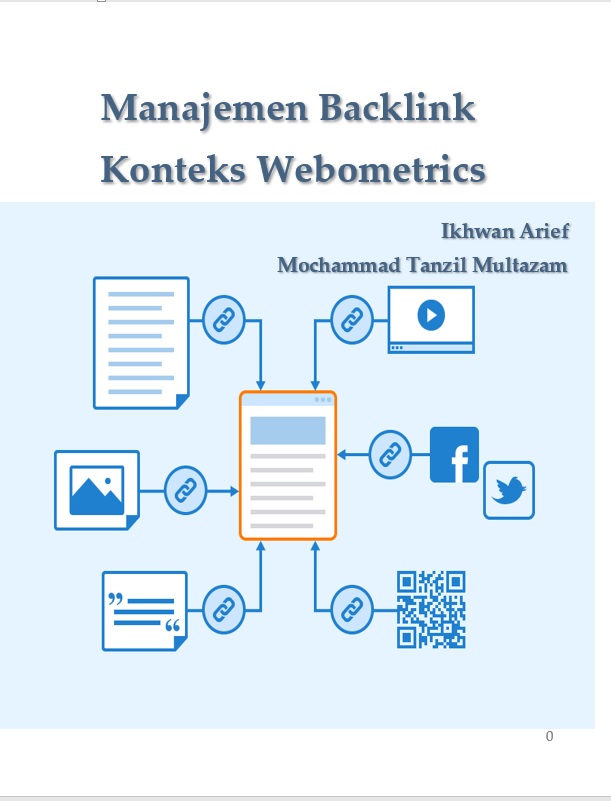Manajemen Backlink Konteks Webometrics
DOI:
https://doi.org/10.21070/2023/978-623-464-069-4Keywords:
Backlink, Konteks, WebometricsAbstract
Buku ini dipersembahkan untuk pelajar, peneliti, dan praktisi dalam bidang Analisis Data dan Pemasaran Digital, serta bagi para pembuat kebijakan dan pengambil keputusan di perguruan tinggi. Buku ini dibentuk sebagai modul pelatihan dan pendukung perkuliahan yang akan membantu dalam mendorong peringkat Webometrics institusi menjadi lebih baik. Pada buku ini juga disertakan ilustrasi kasus sederhana dan soal-soal latihan pada setiap modul untuk mengukur pemahaman Anda mengenai topik yang sudah dibahas.Peringkat Webometrics bukan hanya menjadi tolok ukur prestisius, tetapi juga menjadi refleksi dari kualitas dan relevansi perguruan tinggi di kancah pendidikan dan penelitian global. Ada tiga indikator utama Webometrics: visibility, transparency, dan excellence.Visibility mencakup dampak konten web dan diukur berdasarkan jumlah jaringan eksternal yang menautkan ke halaman web institusi Anda. Transparency atau openness, menggambarkan sejauh mana institusi berbagi pengetahuan dan hasil penelitian, diukur berdasarkan jumlah kutipan dari para peneliti papan atas. Excellence merujuk pada keberhasilan perguruan tinggi dalam menghasilkan penelitian berdampak tinggi, diukur berdasarkan sejauh mana penelitian Anda termasuk dalam 10% karya paling banyak dikutip dalam berbagai disiplin ilmu.Buku ini dipersembahkan untuk pelajar, peneliti, dan praktisi dalam bidang Analisis Data dan Pemasaran Digital, serta bagi para pembuat kebijakan dan pengambil keputusan di perguruan tinggi.
Downloads
References
Aguillo, I. F. (2009). Measuring the institution's footprint in the web. Library Hi Tech, 27(4), 540-556. https://doi.org/10.1108/073788309
Bar-Ilan, J. (2010). Citations to the "Introduction to informetrics" indexed by WOS, Scopus and Google Scholar. Scientometrics, 82(3), 495-506. https://doi.org/10.1007/s11192-010-0185-9
Bangani, S., & Tshetsha, V. (2018). Collaboration on Libguides in public universities in South Africa. Global Knowledge, Memory and Communication, 67(4/5), 259-275. doi:10.1108/gkmc-11-2017-0099
Curiac, C., & Doboli, A. (2022). Combining informetrics and trend analysis to understand past and current directions in electronic design automation. Scientometrics, 127(10), 5661-5689. doi:10.1007/s11192-022-04481-9
Delgado-López-Cózar, E., & Cabezas-Clavijo, Á. (2013). Ranking journals: Could Google Scholar Metrics be an alternative to Journal Citation Reports and Scimago Journal Rank? Learned Publishing, 26(2), 101-114. https://doi.org/10.1087/20130206
Enge, E., Spencer, S., Stricchiola, J., & Fishkin, R. (2015). The Art of SEO: Mastering Search Engine Optimization. O'Reilly Media.
Fishkin, R. (2018). Lost and Founder: A Painfully Honest Field Guide to the Startup World. Penguin Books.
Kaushik, A. (2010). Web Analytics 2.0: The Art of Online Accountability and Science of Customer Centricity. Sybex.
Ledford, J. L., Teixeira, J., & Tyler, M. E. (2010). Google Analytics (3rd ed.). Sybex.
Mejia, C., Wu, M., Zhang, Y., & Kajikawa, Y. (2021). Exploring topics in bibliometric research through citation networks and semantic analysis. Front. Res. Metr. Anal., 6. doi:10.3389/frma.2021.742311
Nezai, A., Ramli, M., & Refafa, B. (2022). The relationship between the scientific activities in research laboratories with webometrics ranking of Algerian universities: An empirical investigation. BEL, 6(1), 67-82. doi:10.21272/bel.6(1).67-82.2022
Orduña-Malea, E. (2021). Dot-science top level domain: Academic websites or dumpsites?. Scientometrics, 126(4), 3565-3591. doi:10.1007/s11192-020-03832-8
Ortega, J. L., & Aguillo, I. F. (2009). Mapping world-class universities on the web. Information Processing & Management, 45(2), 272-279. https://doi.org/10.1016/j.ipm.2008.10.001
Pislyakov, V., & Shukshina, E. (2014). Measuring excellence in Russia: Highly cited papers, leading institutions, patterns of national and international collaboration. J Assn Inf Sci Tec, 65(11), 2321-2330. doi:10.1002/asi.23093
Thelwall, M. (2009). Introduction to Webometrics: Quantitative Web Research for the Social Sciences. Morgan & Claypool Publishers. doi:10.1007/978-3-031-02261-6
Thelwall, M., Haustein, S., Larivière, V., & Sugimoto, C. (2013). Do altmetrics work? Twitter and ten other social web services. PLoS ONE, 8(5), e64841. doi:10.1371/journal.pone.0064841
Timoshenko, G. (2021). Virtual tools for managing the rating promotion of universities. Scientific Research and Development Economics of the Firm, 10(3), 93-104. doi:10.12737/2306-627x-2021-10-3-93-104
Topkanlo, H., & CheshmehSohrabi, M. (2023). Identification and classification of evaluation indicators for scientific and technical publications and related factors. IR, 28(1). doi:10.47989/irpaper953
Unger, R., & Krum, R. (2016). Digital Metrics Field Guide: The Definitive Reference for Brands Using the Web, Social Media, Mobile Media, or Email. Pearson FT Press.
Webometrics. (2023). Ranking Web of Universities. Diakses 17 Juli 2023, dari https://www.webometrics.info/en
Vaughan, L., & Yang, R. (2012). Web data as academic and business quality estimates: A comparison of three data sources. J Am Soc Inf Sci Tec, 63(10), 1960-1972. doi:10.1002/asi.22659
Yekini, N., Adigun, O., & Akinwole, A. (2022). Empirical analysis of webometric ranking in Nigeria polytechnics education

Downloads
Published
How to Cite
License
Authors retain copyright and grant the Umsida Press right of first publication with the work simultaneously licensed under a Creative Commons Attribution 4.0 International License that allows others to share the work with an acknowledgement of the work's authorship and initial publication in this platform.

